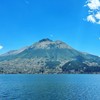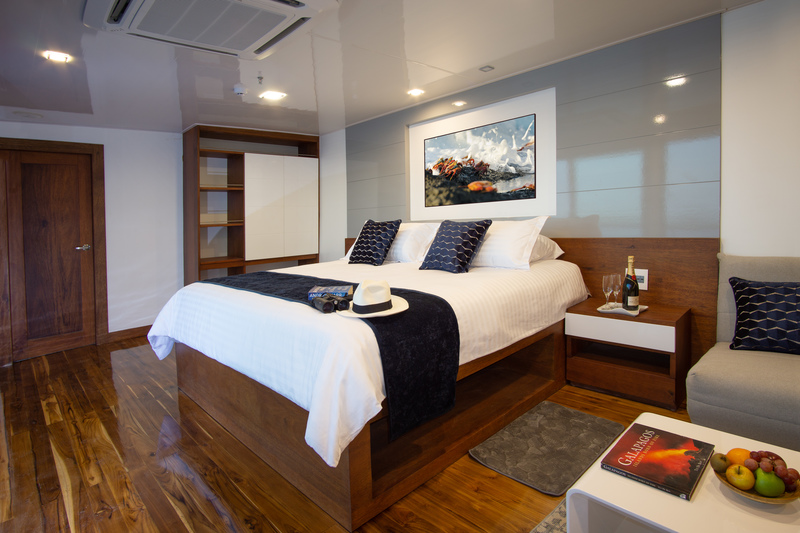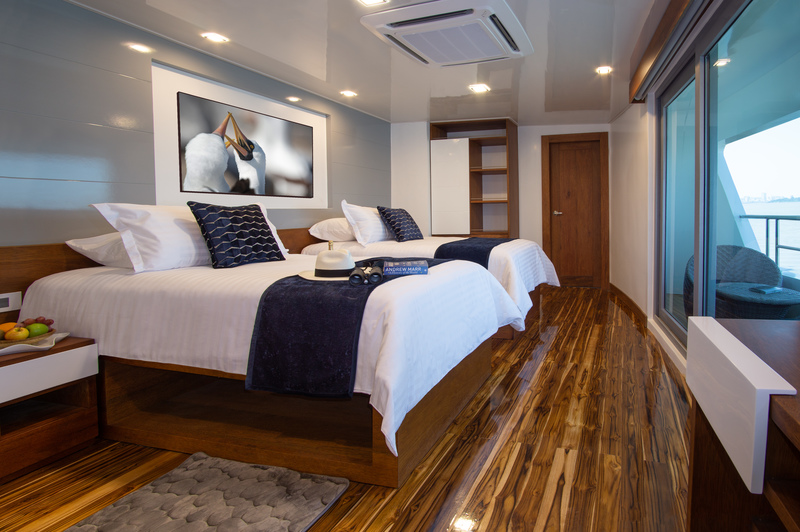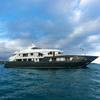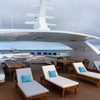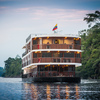Day 1: Tuesday SANTA CRUZ ISLAND
In the morning.- Morning flight from Quito or Guayaquil to Baltra, Galapagos Islands. You will arrive at Baltra Island in the morning. After passing through immigration and baggage claim, you will be met by a Infinity staff member and transferred to the yacht. You will be shown to your cabin where you will have some time to settle in before lunch and a welcome briefing.
In the afternoon.- Visit Black Turtle Cove in the northern part of Santa Cruz. This inlet is surrounded by mangroves and is only accessible by dinghy. The shallow cove is a haven for young marine life. Black-tip and white-tip reef sharks, sea turtles, and a variety of rays are often spotted here
Day 2: Wednesday GENOVESA ISLAND
In the morning.- El Barranco, also known as Prince Phillip’s Steps, is a steep, rocky path that leads up a high cliff rock face. A marvelous view can be appreciated from here. This site is also home to Palo Santo vegetation as well as red-footed boobies, short-eared owls, Galapagos storm petrels, and Galapagos doves.
In the afternoon.- Visit the white-sand coral beach of Darwin Bay which includes a half mile trail (0,75km) that winds through mangroves filled with land birds. Nazca boobies, red-footed boobies, and swallow-tailed gulls, which can easily be spotted here. Further down the path we’ll find tidal pools where sea lions swim playfully. At the end is a spectacular view of a cliff.
Day 3: Thursday SANTIAGO AND RABIDA ISLANDS
In the morning.- You will visit Sullivan Bay located on the southeast part of Santiago. This place is interesting for its geology because the area is covered by lava flows. This place has elevations in the form of small volcanoes formed by the lava flows.
In the afternoon.- You will visit Rabida Island (or Jervis) which is one of the most colorful and volcanically varied islands in the archipelago as well as a great snorkeling site. We will start on Rabida’s famous maroon/red sand beach, and after an easy hike, you will arrive to a stunning lookout to enjoy the amazing landscapes. The island is a birdwatcher’s delight. Some species are abundant such as a few varieties of finches, Galapagos vermilion flycatchers, Galapagos hawks and brown pelicans
Day 4: Friday SANTA CRUZ ISLAND
In the morning.- You will visit “Fausto Llerena” Giant Tortoises Creeding Center in Puerto Ayora, Santa Cruz Island, where giant tortoises are bred in captivity; this is home to tortoises ranging from 3-inches (new hatchlings) to 4-feet long adults. Subspecies of the giant tortoises interact with one another, and many of the older tortoises are accustomed to humans stretching out their heads for a photo opportunity. The babies are kept until they are about four years-old and strong enough to survive on their own.
In the afternoon.- El Chato reserve is divided into two areas: Caseta and Chato. The trail begins at Santa Rosa (13.7 miles / 22 km) from Puerto Ayora, with the Caseta route being the most challenging. The reserve allows visitors to observe giant tortoises in the wild during the dry season and is also a good place to spot short-eared owls, Darwin’s finches, yellow warblers, Galapagos rails and paint-billed crakes.
Day 5: Saturday SANTA CRUZ ISLAND
In the morning.-The visitors’ site at Dragon Hill is located in northwestern Santa Cruz Island and consists of a 1,600 m long trail that runs through three different environments. The beach is very rocky. At high tide it’s a nice place for snorkeling. At this visiting site you can find vegetation of the typical intertidal zone and dry zone
In the afternoon.-Bachas Beach is located on the north shore of Santa Cruz and is a beach for swimming. One of the few remnants of the U.S. World War II presence in the Galapagos, a floating pier, can be seen here. You may see flamingos, Sally Lightfoot crabs, hermit crabs, black-necked stilts, and whimbrels. Sea turtles also nest on the beach.
Day 6: Sunday FLOREANA ISLAND.-
In the morning.- You will land on a beach and head to a spot where 18th century whalers placed a wooden barrel used as an unofficial mail box. The custom continues to this day with Galapagos visitors. So, don’t forget your postcards, and don’t be surprised if the post card arrives to its destination before you even get home!
In the afternoon.- Cormorant Point hosts a large flamingo lagoon where other birds such as common stilts and white-cheeked pintails can also be seen. The beaches on this island are distinct: The Green Beach is named so due to its green color, which comes from a high percentage of olivine crystals in the sand, and the Four Sand Beach is composed of white coral.
You will have a chance to snorkel around Devil’s Crown which is the rocky remains of an offshore volcano sticking out of the water. This is a great location to spot a wide range of marine creatures.
Day 7: Monday ESPAÑOLA ISLAND
In the morning.- On the trail to Suarez Point you will have the chance to spot blue-footed boobies, albatrosses, and Nazca boobies. This island is the breeding site of nearly all of the world’s 12,000 pairs of waved albatrosses. You will also visit a beautiful site on the ocean front where there is a cliff that the large albatrosses use as a launching pad! You will have the chance to see the famous blowhole that spurts sea water into the air. The landscape is great for photography
In the afternoon.- This excursion takes you to the spectacular Gardner Bay. After landing, you can walk across a lovely white-sand beach amongst a busy sea lion colony or dive into the water to swim with sea lion pups. You may also see curious mockingbirds on the beach.
Day 8: Tuesday SAN CRISTOBAL ISLAND
In the morning.- This site is part of an environment project. The tour of this center will explore the natural history of the islands including human interaction and conservation efforts. The Museum of Natural History explains the volcanic origin of the archipelago, ocean currents, climate, and the arrival of endemic species. The Human History exhibit chronologically describes significant events such as discovery and colonization of the islands.
In the afternoon.- After this final visit, you will be transferred to the San Cristobal airport in time for your flight back to the mainland.
